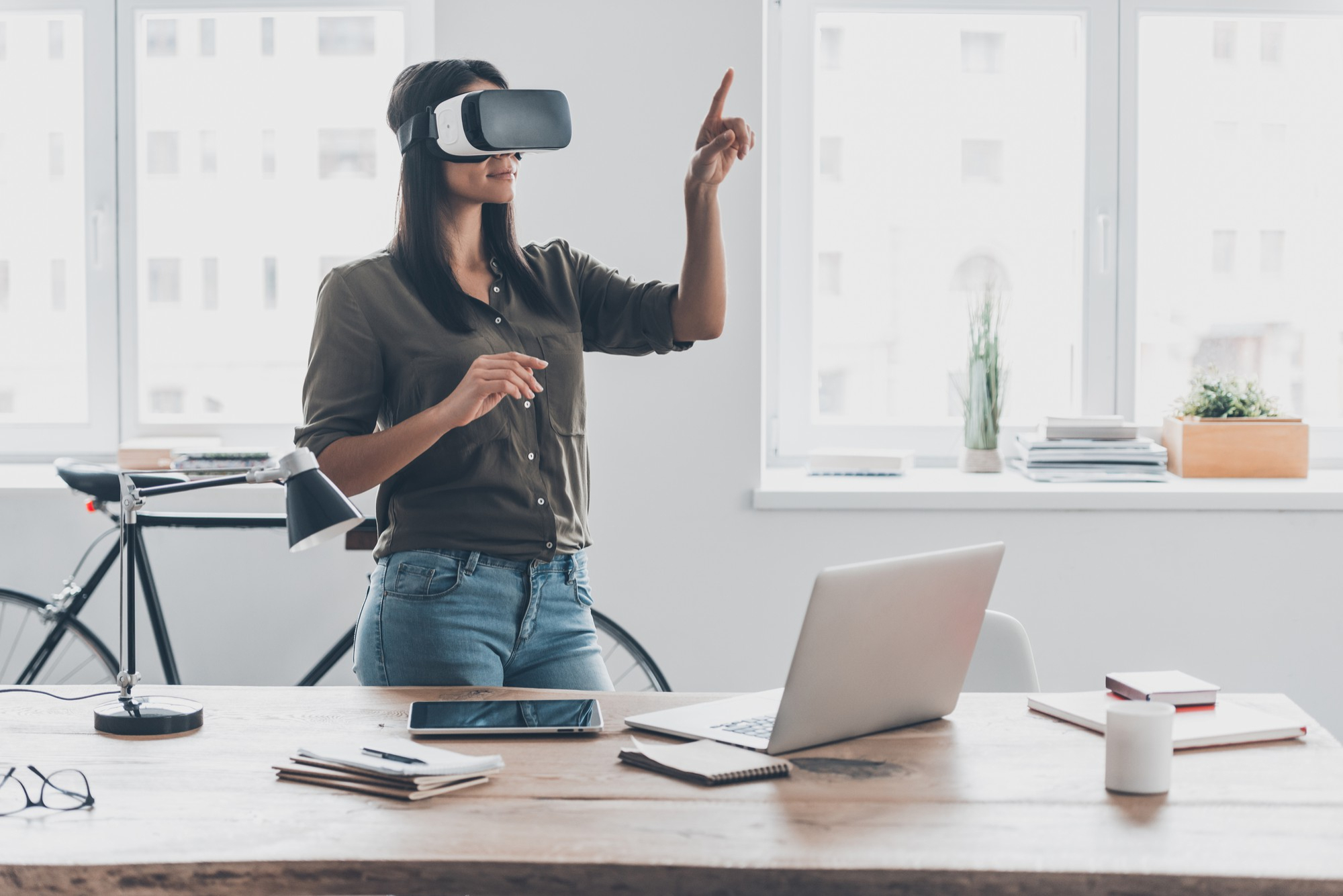Remote work has become the new normal, and virtual reality (VR) is stepping in to revolutionize the way we collaborate, communicate, and stay productive. Imagine attending a meeting in a digital office where you can interact with colleagues as if they were right next to you—no laggy video calls or awkward screen-sharing moments. That’s exactly what VR technology companies are working on. In this article, we’ll explore how VR is changing remote work, the top companies leading the way, and how this technology is making virtual collaboration feel more real than ever.
What is Virtual Reality (VR) in Remote Work?
Virtual reality (VR) in remote work uses immersive technology to create digital environments that allow employees to interact in a more engaging and lifelike way. With VR, remote workers no longer need to stare at flat screens or feel disconnected from their teams. Instead, by wearing VR headsets, they can step into virtual spaces where their workday comes alive.
In these virtual environments, employees can host and attend meetings as if they were sitting together in a physical conference room. The 3D spaces give a sense of presence that traditional video calls simply can’t provide. It’s not just about sitting in front of a screen and talking—it’s about interacting in a dynamic, spatial environment where everyone can see each other’s movements and gestures, making communication feel more natural.
Collaboration also takes on a new form in VR. Virtual whiteboards, shared screens, and interactive 3D tools enable teams to work together on projects in real-time, just as they would in an office setting. The possibilities for brainstorming and problem-solving are expanded, with users able to manipulate objects, draw, and share ideas in an intuitive way.
Moreover, VR offers opportunities for employee training through realistic simulations, allowing staff to practice skills in a controlled, risk-free virtual space. This immersive form of learning can be especially valuable in fields that require hands-on experience, such as healthcare or engineering. Additionally, VR can foster a sense of camaraderie among remote workers, who can socialize and engage with each other in virtual office spaces, helping to combat isolation and build team spirit.
Why VR is the Future of Remote Work
| Benefit | Description | How It Helps Remote Work | Impact on Employees | Example |
| Reducing Zoom Fatigue | Endless video calls can be mentally exhausting. VR meetings create a more natural interaction environment, reducing the strain of staring at a screen all day. | It alleviates the pressure of being constantly on camera and enables richer, more engaging communication. | Reduces mental fatigue, improves focus, and enhances engagement during meetings. | VR meetings allow for spontaneous interactions, much like in-person conversations, with less focus on the screen. |
| Enhancing Collaboration | VR offers interactive 3D tools for brainstorming, which makes remote work more engaging and productive than traditional tools like video calls or chat. | It allows for real-time collaboration with spatial and visual interaction, which is often more effective than text-based discussions. | Makes teamwork more creative, dynamic, and productive by providing hands-on engagement. | Teams can brainstorm on virtual whiteboards or interact with 3D models in real time, allowing for a richer collaborative process. |
| Boosting Productivity | VR offices immerse workers in distraction-free environments, promoting focus and efficiency. | VR helps employees stay focused by minimizing real-world distractions, providing a dedicated workspace. | Improves focus, reduces procrastination, and fosters a more dedicated work mindset. | A VR office can block out real-world distractions like background noise or interruptions, creating a space purely for work. |
| Improving Employee Training | VR simulations offer hands-on training in a risk-free virtual space, allowing employees to practice real-world scenarios safely. | Employees gain practical experience in controlled environments, enhancing their skills and confidence. | Builds confidence, improves skillset, and reduces the likelihood of errors in real situations. | A medical professional can practice surgeries in VR or a pilot can simulate flying a plane before attempting it in real life. |
Top VR Technology Companies Leading the Way
- Meta (formerly Facebook)
Meta is at the forefront of virtual reality, with its Horizon Workrooms providing an immersive virtual office where teams can meet, collaborate, and brainstorm in real-time.- Realistic avatars with facial expressions
- Spatial audio for natural conversations
- Virtual whiteboards for collaboration
- Microsoft (Mesh for Teams)
Microsoft is integrating VR and AR into its Teams platform with Mesh for Teams, enabling employees to join meetings as 3D avatars.- Holographic presence for a more engaging experience
- AI-powered avatars that mimic real-life gestures
- Seamless integration with Microsoft 365
- HTC Vive (VIVE Sync)
HTC’s VIVE Sync offers a VR workspace designed for business collaboration.- Enterprise-level security for confidential meetings
- 3D object sharing for interactive presentations
- Multi-user environments for team projects
- Spatial
Spatial focuses on creating virtual meeting rooms that replicate the feel of face-to-face interactions.- High-fidelity avatars with realistic body language
- Cross-platform support (VR, AR, desktop, mobile)
- Customizable workspaces for different industries
- Varjo
Varjo specializes in providing ultra-realistic VR experiences, making remote work feel truly immersive.- High-resolution VR headsets
- Eye-tracking technology for better interaction
- Real-time collaboration in detailed 3D environments
How VR is Improving Different Aspects of Remote Work
Virtual offices powered by VR are allowing employees to step into immersive workspaces from anywhere in the world. This technology breaks down the barriers of traditional office spaces, enabling individuals to work alongside teammates in real-time despite being physically miles apart. Instead of feeling isolated at home or being confined to static video calls, users can engage in dynamic environments where they interact just like they would in a physical office. Whether it’s meeting in a virtual conference room or collaborating on a project, the feeling of presence and interaction brings a sense of connection and productivity to remote work.
Meetings and conferences in VR offer a natural, engaging alternative to traditional video calls. Unlike standard virtual meetings, VR allows participants to use hand gestures, facial expressions, and other body language cues, making communication far more effective. This enhanced interaction reduces the feeling of detachment often felt in video calls, creating more authentic, meaningful conversations. Additionally, tools like virtual whiteboards enable team members to collaborate in real-time, drawing and sharing ideas as they would in a physical meeting. This more fluid, natural interaction helps keep participants engaged and focused.
Training and skill development have been revolutionized through VR, providing employees with the ability to learn by doing in a realistic, risk-free environment. Companies across various industries—such as healthcare, engineering, and retail—are turning to VR for training simulations that mimic real-world situations. Employees can practice complex tasks, from performing surgeries to troubleshooting machinery, without the risk of real-world consequences. This hands-on approach not only boosts confidence and skills but also accelerates learning, making it more effective than traditional training methods that rely on reading or watching instructional videos.
Finally, VR is bringing remote teams closer together by creating opportunities for socializing and team-building activities. In a traditional remote work setting, employees often miss out on the informal interactions that happen naturally in an office environment, like casual chats by the coffee machine. VR addresses this by creating fun, interactive spaces where team members can bond through virtual games, collaborative activities, and even informal social gatherings. These virtual spaces allow employees to feel more connected, reducing isolation and improving overall team dynamics. Through these shared experiences, teams can build stronger relationships, fostering a sense of belonging even in a remote work setting.
Challenges of Implementing VR in Remote Work
| Challenge | Explanation |
| Cost | High-end VR headsets and software can be expensive. |
| Hardware Requirements | Not all employees have access to powerful computers. |
| Motion Sickness | Some users may experience discomfort when using VR for long periods. |
| Adoption Resistance | Employees may be hesitant to switch from traditional tools to VR. |
The Future of VR in Remote Work
- Lighter and More Affordable VR Headsets
Companies like Meta and Apple are working on creating sleeker, more affordable VR headsets, which will make it easier for businesses to adopt the technology. These advancements aim to reduce the size and cost of the devices while maintaining high-quality performance, allowing more companies to incorporate VR into their remote work setups. - AI-Powered Avatars
In the future, VR platforms will feature AI-driven avatars capable of mimicking human expressions and emotions. These avatars will enhance virtual interactions, making them feel more genuine and lifelike, creating deeper connections between remote team members. The ability for avatars to express emotions and movements will lead to more immersive and meaningful communication. - AR and VR Integration
The integration of Augmented Reality (AR) with VR will create hybrid workspaces where employees can seamlessly transition between digital and physical environments. This blend will allow workers to access virtual tools while interacting with real-world objects, offering a more dynamic and versatile work experience that merges the best aspects of both technologies. - More Industry-Specific VR Solutions
As VR technology matures, more industry-specific solutions will be developed to optimize remote work for various sectors. For example, healthcare, architecture, and education will benefit from tailored VR applications that cater to the unique needs of each field. These custom VR solutions will enhance the remote work experience, providing specialized tools and simulations that improve productivity and learning in diverse industries.
How VR is Revolutionizing the Remote Work Experience
Virtual reality is rapidly transforming the way we work remotely, offering innovative solutions that go beyond traditional video calls and collaboration tools. One of the most significant advancements is the ability to create virtual offices where remote employees can interact in 3D spaces, mimicking the feeling of being physically present with colleagues. Instead of working in isolation at home, VR allows individuals to join a dynamic virtual workspace where they can hold meetings, collaborate on projects, and socialize in ways that traditional remote tools cannot match.
Another major benefit of VR in remote work is the enhanced collaboration it enables. Rather than relying on static screens and text-based communication, VR provides interactive environments where teams can brainstorm, draw on virtual whiteboards, and manipulate 3D objects. This level of interactivity fosters a more engaging and productive collaboration, similar to being in the same room with your colleagues, and allows for faster problem-solving and decision-making. The immersive nature of VR encourages creativity and sparks new ways to approach tasks that might feel tedious through conventional methods.
Training and professional development are also being transformed by VR. Businesses are increasingly using VR for hands-on training in a variety of fields, such as medicine, engineering, and customer service. Employees can practice real-life scenarios in a controlled virtual environment, improving their skills without the risk of costly errors. This not only accelerates the learning process but also enhances the overall retention of information, making training more effective and efficient compared to traditional methods.
Finally, VR is helping to combat the isolation that many remote workers feel by creating virtual spaces for team bonding and socializing. In a remote work environment, it’s easy for employees to feel disconnected from their colleagues, leading to lower morale and a sense of loneliness. However, VR enables employees to interact in a virtual office or attend social events in a way that fosters camaraderie and strengthens team dynamics. By simulating in-person experiences, VR brings remote teams closer together, helping them build trust and stronger working relationships.




